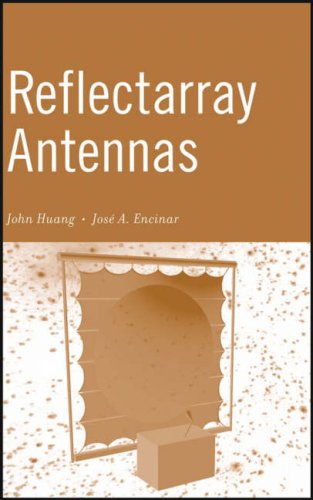

Most ebook files are in PDF format, so you can easily read them using various software such as Foxit Reader or directly on the Google Chrome browser.
Some ebook files are released by publishers in other formats such as .awz, .mobi, .epub, .fb2, etc. You may need to install specific software to read these formats on mobile/PC, such as Calibre.
Please read the tutorial at this link: https://ebookbell.com/faq
We offer FREE conversion to the popular formats you request; however, this may take some time. Therefore, right after payment, please email us, and we will try to provide the service as quickly as possible.
For some exceptional file formats or broken links (if any), please refrain from opening any disputes. Instead, email us first, and we will try to assist within a maximum of 6 hours.
EbookBell Team

4.4
52 reviews
ISBN 10: 047008491X
ISBN 13: 9780470084915
Author: John Huang, Jose Antonio Encinar
1. Introduction to Reflectarray Antennas
1.1 Reflectarray Concept
1.2 Reflectarray Developments
1.3 Overview of this Book
2. Analysis and Design of Reflectarray Elements
2.1 Phase-Shift Distribution on the Reflectarray Aperture
2.2 Phase Tuning Approaches for Reflectarray Elements
2.2.1 Elements with Phase/Time-Delay Lines
2.2.2 Elements with Variable Sizes
2.2.3 Elements with Variable Rotation Angles
2.3 Element Analysis Methods
2.3.1 Periodic Boundary Conditions and Floquet Port Excitation
2.3.2 Metallic Waveguide Simulators
2.3.3 Analytical Circuit Models
2.3.4 Comparison of Element Analysis Techniques
2.4 Examples of Classic Reflectarray Elements
2.5 Reflectarray Element Characteristics and Design Considerations
2.6 Reflectarray Element Measurements
3. System Design and Aperture Efficiency Analysis
3.1 A General Feed Model
3.2 Aperture Efficiency
3.3 Aperture Blockage and Edge Diffraction
3.4 The Analogy between a Reflectarray and a Parabolic Reflector
4. Radiation Analysis Techniques
4.1 Array Theory Approach: The Robust Analysis Technique
4.2 Aperture Field Approach: The Classical Analysis Technique
4.3 Important Topics in Reflectarray Radiation Analysis
4.3.1 Principal Radiation Planes
4.3.2 Co- and Cross-Polarized Patterns
4.3.3 Antenna Directivity
4.3.4 Antenna Efficiency and Gain
4.3.5 Spectral Transforms and Computational Speedup
4.4 Full-Wave Simulation Approaches
4.4.1 Constructed Aperture Currents Under Local-Periodicity Approximation
4.4.2 Complete Reflectarray Models
4.5 Numerical Examples
5. Bandwidth of Reflectarray Antennas
5.1 Bandwidth Constraints in Reflectarray Antennas
5.1.1 Frequency Behavior of Element Phase Error
5.1.2 Frequency Behavior of Spatial Phase Delay
5.1.3 Aperture Phase Error and Reflectarray Bandwidth Limitations
5.2 Reflectarray Element Bandwidth
5.2.1 Physics of Element Bandwidth Constraints
5.2.2 Parametric Studies on Element Bandwidth
5.3 Reflectarray System Bandwidth
5.3.1 Effect of Aperture Size on Reflectarray Bandwidth
5.3.2 Effects of Element on Reflectarray Bandwidth
6. Reflectarray Design Examples
6.1 A Ku-band Reflectarray Antenna: A Step-by-Step Design Example
6.1.1 Feed Antenna Characteristics
6.1.2 Reflectarray System Design
6.1.3 Reflectarray Element Design
6.1.4 Radiation Analysis
6.1.5 Fabrication and Measurements
6.2 A Circularly Polarized Reflectarray Antenna using an Element Rotation Technique
6.3 Bandwidth Comparison of Reflectarray Designs using Different Elements
7. Broadband and Multiband Reflectarray Antennas
7.1 Broadband Reflectarray Design Topologies
7.1.1 Multilayer Multi-Resonance Elements
7.1.2 Single-Layer Multi-Resonance Elements
7.1.3 Sub-Wavelength Elements
7.1.4 Reflectarrays Employing Single-Layer and Double-Layer Sub-Wavelength Elements
7.1.5 Broadband Design Methods for Large Reflectarrays
7.2 Phase Synthesis for Broadband Operation
7.2.1 A Phase Synthesized Broadband Reflectarray
7.2.2 A Dual-Frequency Broadband Reflectarray
7.3 Multiband Reflectarray Designs
7.3.1 A Single-Layer Dual-Band Circularly Polarized Reflectarray
7.3.2 A Single-Layer Tri-Band Reflectarray
8. Terahertz, Infrared, and Optical Reflectarray Antennas
8.1 Above Microwave Frequencies
8.2 Material Characteristics at Terahertz and Infrared Frequencies
8.2.1 Optical Measurements and Electromagnetic Parameters
8.2.2 Measured Properties of Conductors and Dielectric Materials
8.2.3 Calculating Drude Model Parameters for Conductors
8.3 Element Losses at Infrared Frequencies
8.3.1 Conductor Losses
8.3.1.1 Effect of Conductor Thickness
8.3.1.2 Effect of Complex Conductivity
8.3.2 Dielectric Losses
8.3.3 Effect of Losses on Reflection Properties of Elements
8.3.4 Circuit-Model Analysis
8.3.4.1 Circuit Theory and Loss Study
8.3.4.2 Zero-Pole Analysis of Element Performance
8.4 Reflectarray Design Methodologies and Enabling Technologies
9. Multi-Beam and Shaped-Beam Reflectarray Antennas
9.1 Direct Design Approaches for Multi-Beam Reflectarrays
9.2 Synthesis Design Approaches for Shaped- and Multi-Beam Reflectarrays
9.3 Practical Reflectarray Designs
10. Beam-Scanning Reflectarray Antennas
10.1 Beam-Scanning Approaches for Reflectarray Antennas
10.2 Feed-Tuning Techniques
10.3 Aperture Phase-Tuning Techniques
10.4 Frontiers in Beam-Scanning Reflectarray Research
11. Reflectarray Engineering and Emerging Applications
11.1 Advanced Reflectarray Geometries
11.2 Reflectarrays for Satellite Applications
11.3 Power Combining and Amplifying Reflectarrays
11.4 A Perspective on Reflectarray Antennas
reflectarray antennas
aperture efficiency analysis of reflectarray antennas
reflectarray antenna design
why are there two antennas on my router
phased-array antennas
Tags: John Huang, Jose Antonio Encinar, Reflectarray